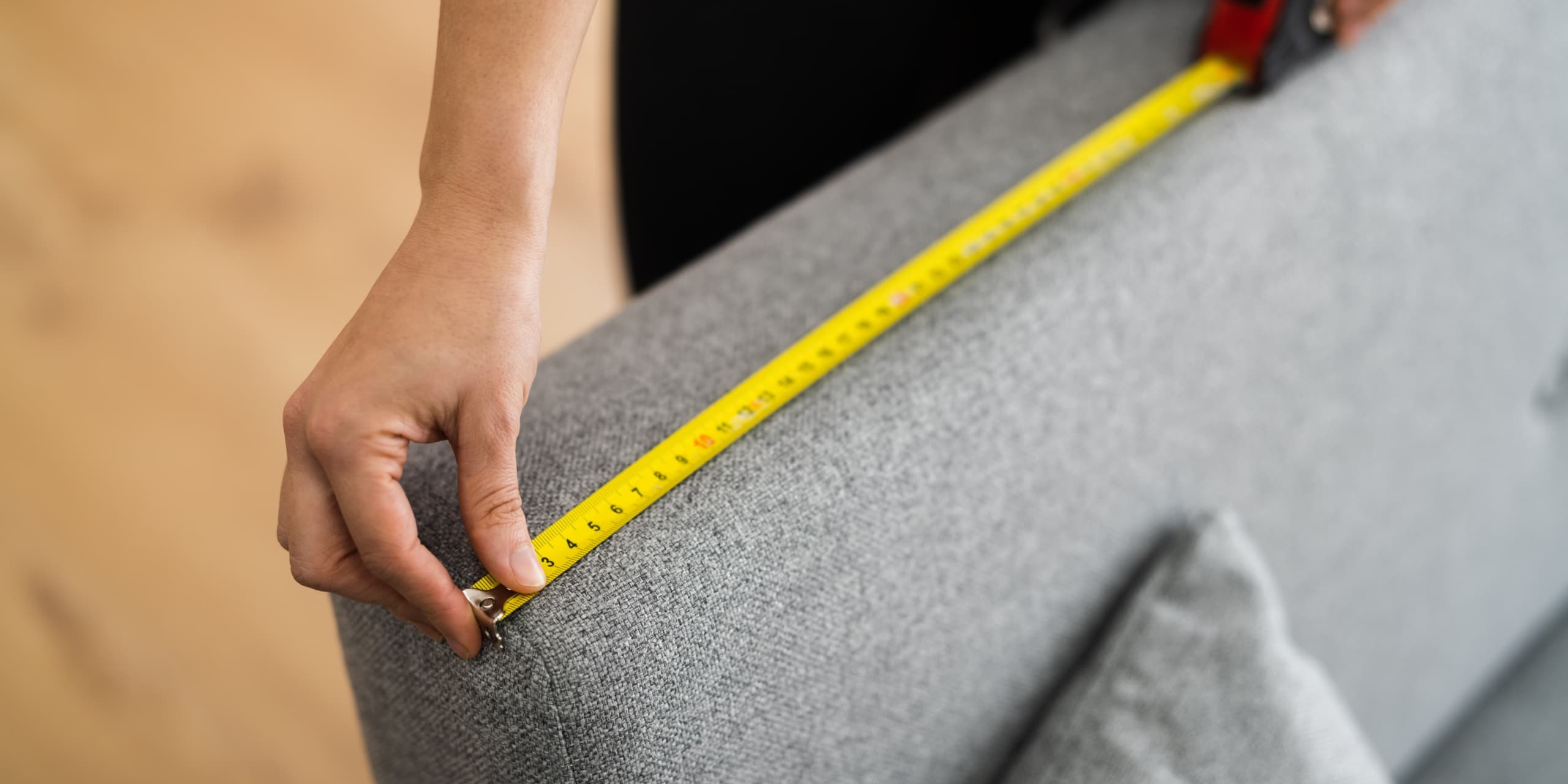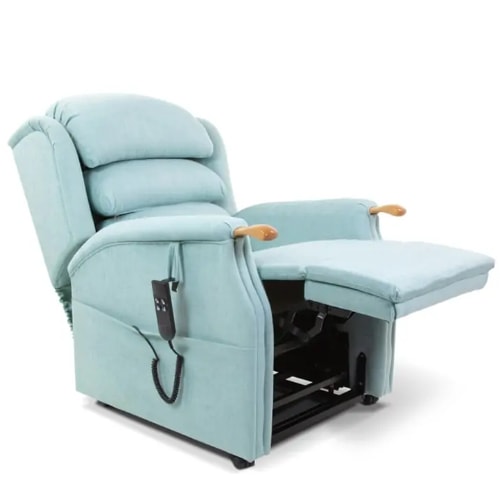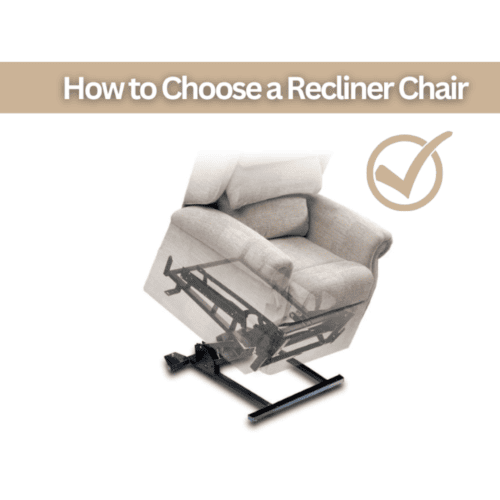Riser Recliner Chair Sizes: How to Measure for a Riser Recliner Chair
Have A Question? Get In Touch

Riser recliner chairs are designed to provide the correct support for users. Whether you’re choosing from standard riser recliner chair sizes, or are having a made-to-measure seat, accurately measuring for your riser recliner chair is essential to ensure the dimensions of the chair provide the necessary support.
With the measurements you obtain, deciding how to choose a riser recliner chair and which is the most suitable chair for the user will be much easier.
Table of Contents
How to Measure for a Riser Recliner
When measured correctly, a riser recliner chair should foremost be comfortable for the user, especially if it will be used daily. The chair should also provide support, by helping the user maintain the correct posture and relieving pressure from vulnerable areas. A chair which is too big will not offer the proper support, whilst one which is too small will be uncomfortable for the user.
Before you take the measurements for your riser recliner chair, ensure you’re prepared with the following:
● A rigid measuring tape, as opposed to a fabric one
● A pen and paper or electronic device to record the measurements
● The chair user is present and seated in a chair which allows access to the body, such as a dining room chair.
A rigid measuring tape will be used to take straight and flat measurements, rather than a fabric measuring tape which can bend to the contours of the user, potentially causing an inaccurate result.
The user must also be seated in a chair which allows the person taking the measurements to access the areas they need. They should be seated with their feet comfortably on the floor, and wearing their typical clothing (if this includes shoes or slippers, they should be worn too).
What do you Measure for a Riser Recliner Chair
The following measurements will give you the dimensions you need to help you choose a riser recliner chair size which is comfortable for the user, and enables them to rise from and sit down in the chair easily.
Seat Height
The first measurement you can take is the seat height. It is important to gauge the correct seat height since the seat needs to be accessible for the user and facilitate their independent mobility as they get in and out of the chair. However, if the chair is too high and the user’s feet cannot touch the floor, there will not be sufficient support which, in time, can cause discomfort and pressure.
How to measure seat height: measure the length from the floor to the crease at the back of the user’s knee.
Seat Depth
Measuring the seat depth correctly will ensure the user’s back is supported without them having to slump and form incorrect posture. However, if the seat depth is likewise too short for the user, their thighs will not be fully supported and they may feel pushed from the chair.
To measure the correct seat depth: ensure the user is sat with their buttocks against the back of the chair, with the hips and knees at a 90° angle. Try not to include any pronounced gluteal shelf in your measurements as this can provide a false result. Measure the length from the back of the knee to the back of the buttocks, before deducting 1” or 25mm.
To accommodate any differences in the length, it is best practice to measure both legs.
Seat Width
The width of your riser recliner must be comfortable enough so that the user has enough room to reposition. If the seat is too wide, the user will not be properly supported by the armrests and may find themselves leaning to one side. On the other hand, if the width is too narrow, the sides of the chair may rub the user and cause discomfort.
Measure the appropriate seat width for a user by: measuring across the widest part of the user (this will typically be the hip area). You should then add on 1” or 25mm to allow for thicker clothing or a blanket, especially if you’re measuring your riser recliner chair for elderly people. This additional space will also account for any movement or a windswept posture.
Arm Height
The height of the chair’s arm rests must also be considered in order for the user to be able to comfortably rest their arms and help themselves in and out of the chair. It is important to measure the correct height to ensure the user can sit with their shoulders relaxed and arms stabilised.
How to measure the arm rest height: the user should hold their arms at a 90° angle at their sides. Then, measure from the seat cushion up to the underside of the middle of the forearm. This will indicate the height you require. To measure the length of the arm rest, measure the length of the user’s forearm to ensure the arm is supported along its length.
Back Height
Getting the correct height for the back of your riser recliner chair is important for supporting the head and maintaining a correct posture. If the head is not fully supported by a chair back which is too low, or pushed forwards by a chair back which is too high, the user could experience discomfort in their neck and shoulders.
When measuring for back height: measure from the buttocks of the user to the top of their head, and again from their buttocks to the top of their shoulder.
Measure the Lumbar Spine
If your user has a spinal abnormality, this should be taken into account when measuring for a riser recliner chair for the user’s comfort and support of the spine. It is recommended you consult a professional, who can advise on how to choose a riser recliner chair for a spinal abnormality – made to measure riser recliners may be necessary.
To measure the lumbar spine: measure from the head of the femur to the middle of the lumbar spine.
How to Measure a Person For a Recliner Chair
In this section, we will walk you through the step-by-step process of measuring for seat width, back height, armrest length, and lumbar spine alignment. Whether you're choosing a recliner chair for yourself or a loved one, our instructions will give you all the information you need to do your measurements.

How to Measure Seat Height
To measure seat height correctly, one needs to focus on the seat-to-floor or footplate length. This measurement determines the distance between the back of the patient's knee and the sole of their foot while they are seated. It is crucial to follow these steps for an accurate measurement:
1.Position the patient in a seated position, ensuring their feet are flat on the floor or footplate.
2.Locate the back of the patient's knee, which serves as the starting point for measurement.
3.Measure from the back of the knee to the sole of the foot, ensuring the measurement is taken in a straight line.
4.Record the measurement carefully, as it will serve as a reference for selecting appropriate seating options.
How to Measure Seat Depth
To measure the correct seat depth:
1. Ensure the user is sat with their buttocks against the back of the chair, with the hips and knees at a 90° angle. Try not to include any pronounced gluteal shelf in your measurements as this can provide a false result.
2. Measure the length from the back of the knee to the back of the buttocks, before deducting 1” or 25mm.
3. Record the Measurement: Carefully note down the measurement, as it will serve as a reference for selecting seating options with the appropriate seat depth.
How to Measure Seat Width
To measure the correct seat width for a user:
1. Measure across the widest part of their body, which is usually the hip area, although occasionally it may be the knees.
2. Once you have obtained the measurement, add 1 inch or 25mm to account for thicker clothing or the presence of a blanket, particularly when measuring a riser recliner chair for elderly individuals.
This extra space will also accommodate any potential movement or a slightly slanted posture caused by wind.
How to Measure Arm Height
To measure the correct arm height for a user:
1. Instruct the user to position their arms at a comfortable 90° angle, resting naturally at their sides.
2. Proceed to measure from the seat cushion up to the underside of the middle of the forearm. This measurement will determine the desired height for optimal arm support.
3. To determine the appropriate length of the armrest, measure the user's forearm length to ensure comprehensive support along the entire arm.
How to Measure Back Height
To measure the correct back height for a user:
1.Ask the user to sit comfortably in an upright position on the chair or seat.
2. Position yourself at the side of the user, ensuring a clear view of their back.
3. Begin by measuring from the user's buttocks up to the top of their head. This measurement will determine the overall height of the backrest needed for adequate support.
4. Next, measure from the user's buttocks to the top of their shoulder. This measurement is essential for determining the optimal positioning and height of the backrest to provide proper support to the user's upper back and shoulders.
5. Ensure that the measurements are taken in a straight line, following the natural contours of the user's back.
How to Measure The Lumbar Spine for a User:
To measure the correct lumbar spine for a user:
1.Begin by having the user sit in a comfortable and upright position, preferably on a chair or seat that provides adequate support.
2.Position yourself at the side of the user, ensuring a clear view of their lower back area.
3.To measure the lumbar spine effectively, start by identifying the head of the femur, which is the bony prominence located at the top of the thigh bone.
4.From the head of the femur, proceed to measure vertically downwards, carefully following the curvature of the user's back, until you reach the midpoint of the lumbar spine. This measurement point typically lies between the lowest rib and the top of the hip bone.
5. Ensure that the measuring tape or device is aligned vertically and stays in contact with the user's back, maintaining a straight and accurate measurement.
FAQ's
When it comes to recliner chairs, their size can differ based on the manufacturer and the particular model. However, there are certain dimensions that are commonly regarded as standard. Our collection of Riser Recliner chairs, for instance, offers a diverse range of widths, spanning from a cozy 18 inches to a generous 35 inches.
Choosing the right recliner chair should be based on the individual's size and comfort. To ensure the perfect fit, we suggest following the steps outlined within this article about measuring a person for a recliner chair. By taking these simple measurements, you'll be able to make an informed decision and provide optimal comfort for the person you're purchasing the chair for
The midsize or average-sized recliner chair typically has a width of around 40 inches. This dimension is commonly found in furniture stores and is designed to provide comfortable seating for a wide range of body sizes. It serves as an average size that caters to the needs of most individuals, ensuring a cozy and accommodating experience
Are You Looking for a Chair For an Elderly Relative?
If you're interested in finding out weather Riser Recliner Chairs are suitable for a elderly relative, check out our next article, where we discuss how riser recliner chairs improve the lives of senior citizens.


